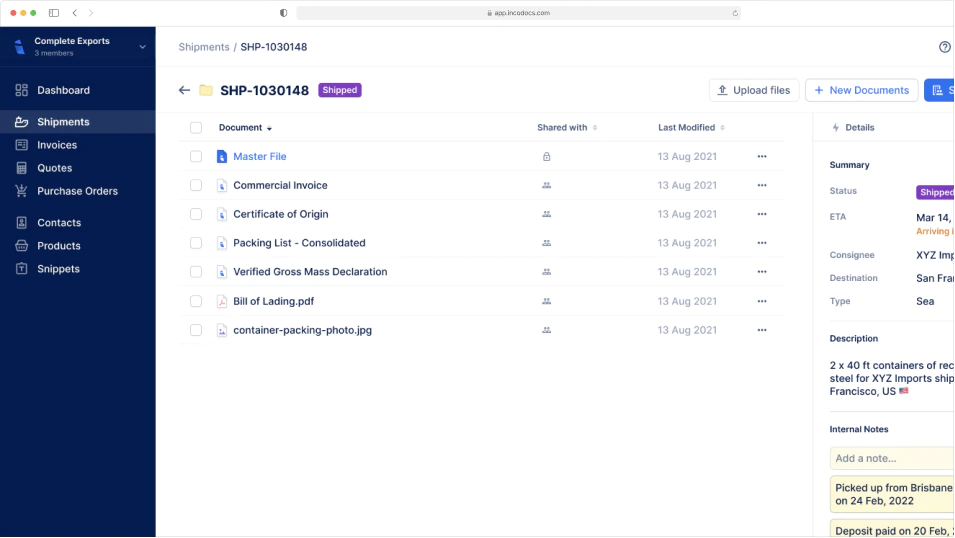IncoDocs raises $1.2M seed round led by Maersk GrowthRead the announcement

Form 9 Transboundary Movement Document Template
What is a Form 9 Transboundary Movement Document used for?
In 1989 the Basel Convention on the control of Transboundary Movements of hazardous wastes and their disposal was adopted. This was in response to the discovery of deposits of toxic wastes that were found in developing countries that were imported from other countries. As such, new regulations came into effect to protect human health and the environment against the adverse effects of hazardous wastes, and exporters shipping hazardous waste cargo were required to submit additional documentation. Read more about the Basel Convention here.
How to create a Form 9 Transboundary Movement Document
Open IncoDocs
Open IncoDocs in your browser and navigate to the “Export Docs” section.
Choose the Form 9 Transboundary Movement Document template
Click on 'New document set' and select the Form 9 Transboundary Movement Document template along with any other export documents you wish to create.
Fill out & customize your doc
Fill out the document, customize template fields to your needs and add your company letterhead. To save time and prevent re-entry errors, enter key shipment data into the Master File to have it sync across all other documents in your set automatically.
Sign & seal
Click on the signature box at the bottom of your document to create and place a digital signature then hit “Save & Quit”. On the document preview screen, click on the ‘More’ dropdown button and select “Add company seal” to place a digital stamp.
Download or share
Download or share documents from IncoDocs in 1-click. Documents can be downloaded as PDF or CSV which can be imported into other systems without manual re-entry.
Your questions, answered.
What is a Form 9 Transboundary Movement Document used for?
In 1989 the Basel Convention on the control of Transboundary Movements of hazardous wastes and their disposal was adopted. This was in response to the discovery of deposits of toxic wastes that were found in developing countries that were imported from other countries.
New regulations came into effect to protect human health and the environment against the adverse effects of hazardous wastes. Read more about the Basel Convention here.
What information is included on a Form 9 Transboundary Movement Document?
It’s important that shippers include relevant information on the form 9 document so that the relevant customs departments and authorities can check and submit information as required. The details are to be provided by the exporter or importer of goods. Shippers, customs and relevant government departments will maintain records of the transport of these goods for historical use.
Some of the information to be included on a form 9 Transboundary Movement document includes:
Contact Party information
This includes contact details of all parties that are involved in the movement of such goods. This includes Company name, registered address, company registration numbers, contact names, phone numbers and email addresses. Parties include the exporter, generator of the waste, importer or actual user, trader and transporter(s) of the waste.
Transport details, including:
Detailed description of waste, including:
Method of Recovery and R Code:
Additional Information and Declarations
Additional documentation such as a copy of the Bill of Lading (proof of shipment from the carrier) will also be required. Declarations and/or signatures will be required by the Exporter, Importer and Transporter(s) of the waste.
How does Form 9 help in managing hazardous waste more effectively?
Form 9 provides a standardized way to document and track hazardous waste shipments. It includes detailed information on waste types, quantities, and recovery methods. This helps ensure that hazardous waste is managed in an environmentally sound manner, supports regulatory compliance, and facilitates efficient recovery processes, reducing the risk of environmental contamination.
What environmental benefits does Form 9 offer?
Form 9 promotes the recycling and reclamation of hazardous waste, reducing the amount of waste that needs to be disposed of. This supports a circular economy, minimizes environmental pollution, and conserves natural resources by turning waste into reusable materials.
How does the Basel Convention impact the use of Form 9?
The Basel Convention sets international standards for the safe and environmentally sound management of hazardous waste movements. It requires detailed documentation, including Form 9, to ensure that hazardous waste is properly handled and recovered. This helps prevent illegal dumping and ensures that all shipments comply with international laws, protecting both human health and the environment.
How does the Prior Informed Consent (PIC) procedure work with Form 9?
The Prior Informed Consent (PIC) procedure is a key component of the Basel Convention. It ensures that all countries involved in the transboundary movement of hazardous waste are fully informed and agree to the shipment before it takes place. Here’s how it works:
More Information
View more information from the Organisation for Economic Co-operation and Development’s (OECD) Guidance Manual for the Control of Transboundary Movements of Recoverable Wastes.
Free to start,
Easy to use.
Setup in 5 mins.
